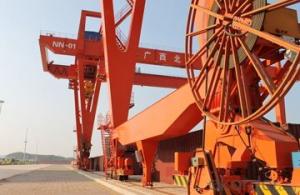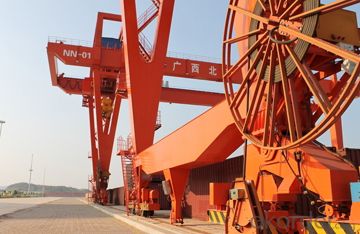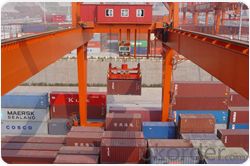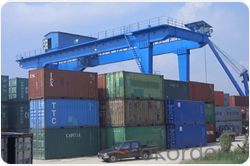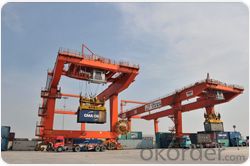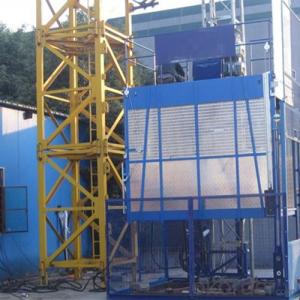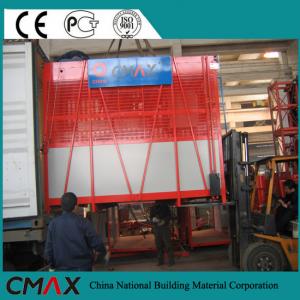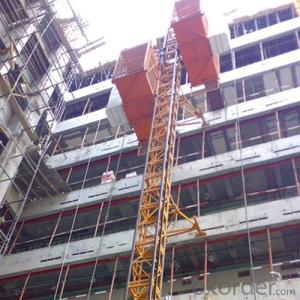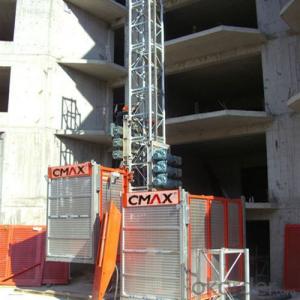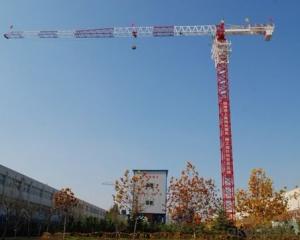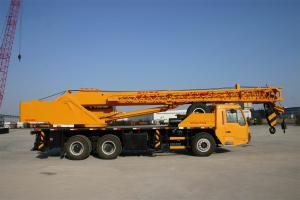Rail Mounted Container Crane to lift 20'40' ISO standard container
- Loading Port:
- Shanghai
- Payment Terms:
- TT OR LC
- Min Order Qty:
- 1 unit
- Supply Capability:
- 20 unit/month
OKorder Service Pledge
OKorder Financial Service
You Might Also Like
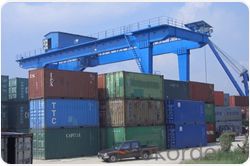
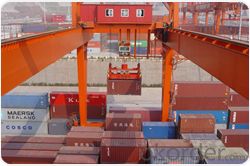
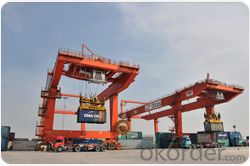
Rail-mounted container gantry cranes(RMG) is a specialized yard container handling machine. It can travel on rail by means of the yard power, and lift an stack containers in the yard area with the equipment of the 20' or 40' telescopic spreader (or twin-lift spreader if needed).Compared with the rubber-tyre gantry crane (RTG), the RMG has the advantage of being driven by electrical power, clean, bigger lifting capacity, an high gantry traveling speed with cargo. The RGM consists of lifting mechanism, trolley traversing mechanism, gantry mechanism and sway-dampening mechanism.
The lifting, gantry and trolley mechanisms are mostly equipped with AC frequency conversion control system. Normally the lifting mechanism is of the single drum type.It can also be designed to be double drum type if needed. Our corporation can design and manufacture according to demands of user.
Working condition:
working temperature: -25-40 °C(can be specially designed to -40°C-+40°C)
Lifting capacity under spreader is 30.5t 35.0t 40.5t and 50.0t;
Working duty: A6- A8.
Power source: 380V 50Hz 3Phase. And we can design as your demands.
The altitude height of site is ought to be less than 2000M.
Flammable, explosive and corrosive gas is forbidden in the work environment.
The crane is forbidden to lift fuse and blend deleterious article and flammable explosive article.
Safety:
Overload protection.
Main lifting motor with thermal protection.
Rubber buffers.
Protective earthing.
Anti sway electric system
Crane switch and travel end switch.
Emergency switch can stop all movement when any dangerous happened.
Sub-assemblies characteristic are tested before assembly.
All cranes must be pre-assembled and tested before leaving factory and offer the certification of test.
Features:
Full electric drive technology. Energy saving and environmental protection. Reduce operation and maintenance costs.
Frequency conversion. Accurate locating container and improving working efficiency.
PLC control, which can meet the automation demand of modern container yard.
Tailored designs. Our product will be designed to your container yard most suitably.
Technical Data:
Capacity of Spreader | t | 30.5 | 35 | 40.5 | 50 | ||
Working Duty | A6-A8 | A6-A8 | A6-A8 | A6-A8 | |||
Span(m) | S | 35 | 35 | 35 | 35 | ||
Base(m) | B | 16 | 16 | 16 | 16 | ||
Lifting Height(m) | H | 15.4 | 15.4 | 18.2 | 18.2 | ||
Speed | Hoisting | With Full Load | m/min | 12 | 12 | 18 | 18 |
Only with Spreader | 24 | 24 | 36 | 36 | |||
Travese | 60 | 60 | 70 | 70 | |||
Traveling | 45 | 45 | 45 | 45 | |||
Total Power | kw | ~200 | ~230 | ~255 | ~300 | ||
Max.working Load of Wheel | kn | 260 | 260 | 280 | 300 | ||
Crane Rail | P50 | P50 | P50 | QU80 | |||
Power Supply | 3-phase AC 380v 50Hz or as your demand | ||||||
- Q: This question asks about the criteria for determining when a building hoist has reached the end of its useful life and should be replaced.
- <p>The lifespan of a building hoist is determined by several factors including its design, materials, usage, maintenance, and compliance with safety standards. Regular inspections and maintenance are crucial to assess the hoist's condition. A hoist should be replaced when it shows significant wear, has been in service beyond the manufacturer's recommended lifespan, or fails to meet safety standards. Additionally, any hoist that has been involved in an accident or has undergone major repairs may need to be replaced to ensure safety. Consulting the manufacturer's guidelines and local regulations can provide specific information on when a hoist should be retired.</p>
- Q: This question asks for a comparison of the pros and cons associated with the use of electric building hoists in construction.
- <p>Electric building hoists offer several advantages such as ease of operation, reduced manual labor, and increased efficiency in lifting and transporting materials. They are also safer compared to manual hoists, reducing the risk of accidents. Additionally, they can handle heavier loads and operate in various weather conditions. However, they have some disadvantages too. For instance, they require a power source and can be less reliable during power outages. They also involve higher initial costs and maintenance expenses. Electric hoists can be noisy, which may lead to noise pollution, and they can be complex to install and operate, requiring skilled personnel.</p>
- Q: Can a building hoist be utilized for the transportation of objects within and between buildings?
- <p>Yes, building hoists are specifically designed to move objects vertically within buildings. They are commonly used in construction to lift materials and equipment to different floors. Additionally, they can be employed to transport objects into and out of buildings, especially when access is limited or when heavy loads need to be moved over short vertical distances. However, it's important to adhere to safety guidelines and regulations when operating a building hoist to ensure the secure and efficient movement of objects.</p>
- Q: This question asks for steps to ensure that lifting equipment is safe and reliable before it is used.
- <p>To ensure your lifting equipment is safe and reliable before use, follow these steps: Inspect the equipment for any visible damage or wear. Check all safety features such as hooks, cables, and brakes. Ensure that the equipment is properly maintained and serviced according to the manufacturer's guidelines. Verify that all safety certifications and inspection records are up to date. Conduct a thorough pre-use check, including testing the equipment's lifting capacity and stability. Ensure that all operators are trained and certified to use the equipment. Never use equipment that has not been inspected or is showing signs of damage. Always follow the manufacturer's guidelines and safety protocols.</p>
- Q: The difference between the derrick and the construction elevator?
- They're the same. HAULOTTE answer for you
- Q: Is it possible to utilize a building hoist for the purpose of moving materials up and down in a warehouse setting?
- <p>Yes, a building hoist can be used to lift and lower materials in warehouses. These hoists are designed for vertical transportation of goods and are particularly useful in multi-story warehouses where space is limited. They are capable of handling heavy loads and can be operated manually or with electric power, making them efficient for moving materials between different levels of a warehouse. However, safety measures and proper maintenance are crucial to ensure the secure and effective operation of the hoist.</p>
- Q: The user is asking if it's possible to use a building hoist, typically used for construction, to lift a car.
- <p>Using a building hoist to lift a car is not recommended. Building hoists are designed for lifting materials and equipment in construction settings, not for vehicles. They may not have the appropriate safety features or load-bearing capacity for a car. Attempting to lift a car with a building hoist could result in damage to the car, the hoist, or even personal injury. For lifting a car, it's best to use a vehicle-specific lift or a hydraulic lift designed for such purposes, ensuring safety and proper support.</p>
- Q: What are the primary materials and components typically utilized in the construction of building hoists?
- <p>Building hoists, also known as construction hoists, are typically made from a combination of steel, aluminum, and sometimes plastic. The frame and main structure are usually constructed from steel for strength and durability. Aluminum is often used for components like the platform and railing due to its lightweight properties, which can reduce the overall weight of the hoist. Plastic components may be used for certain parts to enhance resistance to weather and corrosion. Additionally, hoists may incorporate electrical and mechanical systems, which include cables, gears, and motors, to facilitate the hoisting and lowering of materials and personnel.</p>
- Q: What is the purpose of a building hoist and can it be utilized for lifting heavy objects that cannot be manually lifted?
- <p>Yes, building hoists are specifically designed to lift heavy objects that are beyond the capacity of manual lifting. They are essential in construction sites for moving materials such as bricks, cement, and steel beams to various levels of a building. Building hoists are engineered to handle significant weight and ensure the safe and efficient transport of materials, reducing the risk of injury and improving productivity on construction sites.</p>
- Q: The elevator is banned from using elevators for more than a class of high winds
- When the wind speed is more than 13 meters per second, the installation and disassembly is forbidden. When the wind speed exceeds 20m/s and the weather, such as hail, the elevator should not be used. This is the norm M/s is about 8, and 13m/s is about 6
Send your message to us
Rail Mounted Container Crane to lift 20'40' ISO standard container
- Loading Port:
- Shanghai
- Payment Terms:
- TT OR LC
- Min Order Qty:
- 1 unit
- Supply Capability:
- 20 unit/month
OKorder Service Pledge
OKorder Financial Service
Similar products
Hot products
Hot Searches
Related keywords
